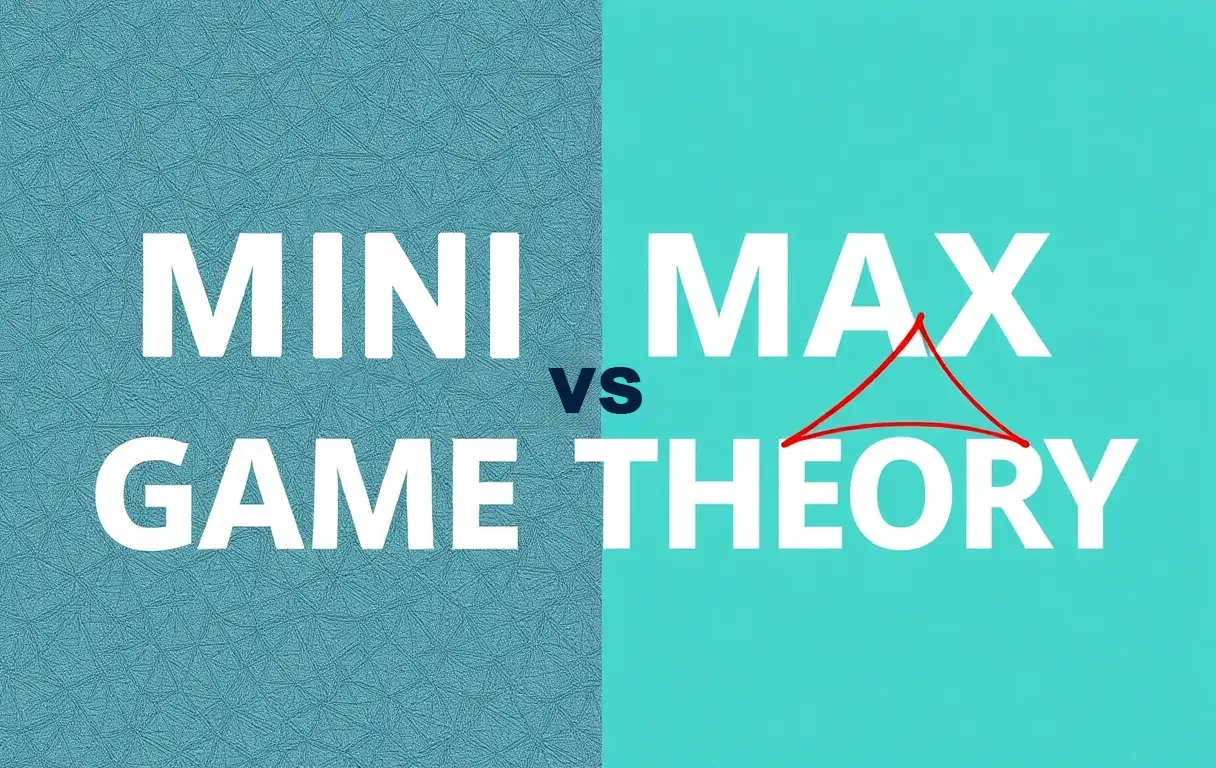
The interplay between minimax algorithms and game theory has shaped strategic decision-making in fields ranging from artificial intelligence to economics. While minimax is a specific algorithmic tool, game theory encompasses a broader theoretical framework for analyzing decision-making among rational agents
This article unpacks their differences, overlaps, and applications, diving into core concepts like the Nash equilibrium and the role of minimax in AI-driven strategies.
Minimax: A Deep Dive into the Algorithm
How Minimax Works in Decision-Making
The minimax algorithm operates by simulating all possible outcomes of a game, identifying optimal strategies to minimize potential loss while maximizing gain. It’s especially effective in two-player zero-sum games.
- Zero-Sum Dynamics: In zero-sum games, one player’s gain is another’s loss. Minimax evaluates the entire decision tree to ensure rational, win-oriented moves.
- Key Applications: It’s widely used in AI for games like chess, tic-tac-toe, and checkers, where decisions need deterministic reasoning.
Strengths and Limitations of Minimax
While the algorithm excels in controlled environments, it struggles in complex, multi-agent scenarios.
- Strengths:
- Provides a clear, step-by-step decision process.
- Ensures an optimal strategy against an opponent.
- Weaknesses:
- Computational intensity due to exhaustive tree evaluations.
- Limited applicability to non-zero-sum games or cooperative contexts.
Minimax’s Connection to Rationality
Minimax assumes fully rational players, which may not align with real-world scenarios where emotions, biases, or incomplete information are at play.
Game Theory: A Broader Conceptual Framework
Core Principles of Game Theory
Game theory studies strategic interactions where multiple players make decisions to maximize their own payoffs, considering the actions of others.
- Key Definitions:
- Players: Decision-makers in a game.
- Strategies: Plans or rules dictating players’ moves.
- Payoffs: Rewards or penalties resulting from chosen strategies.
- Types of Games: Includes zero-sum, cooperative, and non-cooperative games.
Nash Equilibrium: A Cornerstone of Game Theory
A Nash equilibrium occurs when no player can improve their outcome by changing their strategy unilaterally.
- In Relation to Minimax: In zero-sum games, the Nash equilibrium often aligns with the minimax solution, as both reflect stable strategies.
Game Theory’s Breadth Beyond Minimax
Unlike minimax, game theory addresses a range of scenarios, including non-zero-sum games, incomplete information, and dynamic games.
- Examples:
- Prisoner’s Dilemma: Highlights suboptimal outcomes in cooperative dilemmas.
- Market Competition: Models firm strategies in competitive industries.
Minimax in Strategic AI and Economics
Role in Artificial Intelligence
Minimax forms the foundation for many strategic AI systems. It’s used in game engines and decision-support systems for reasoning under competitive conditions.
- AI Game Playing: Chess engines like Stockfish use minimax with heuristics for efficiency.
- Adversarial Scenarios: Security systems leverage minimax to predict and counter threats.
Economic Insights via Minimax
In economic models, minimax aids in predicting outcomes where parties act in opposition, such as in auctions or bargaining.
- Example: A buyer and seller may use minimax principles to negotiate prices, simulating worst-case outcomes.
Bridging Minimax and Game Theory
Where They Overlap
Both minimax and game theory seek optimal strategies in decision-making but approach it from different angles.
- Shared Context: Both excel in zero-sum games.
- Core Assumptions: Both rely on rational players and predictable strategies.
Distinctions in Broader Applications
Minimax is algorithmic, with a computational focus, while game theory provides conceptual tools for analyzing broader strategic situations.
- Beyond Algorithms: Game theory incorporates psychological and behavioral factors.
- Algorithm in Context: Minimax is a practical tool within game theory’s vast theoretical landscape.
Advanced Applications of Minimax and Game Theory
Minimax in Real-World AI Scenarios
As AI evolves, minimax has become integral to addressing complex adversarial challenges.
- AI and Adversarial Networks: Generative Adversarial Networks (GANs) employ concepts akin to minimax. The generator and discriminator operate in opposition, refining outcomes through competitive feedback loops.
- Autonomous Systems: In robotics, minimax helps optimize strategies for navigation and resource allocation in competitive or hostile environments.
- Cybersecurity: Minimax principles underpin defense strategies in scenarios like intrusion detection, simulating hacker and defender actions.
Beyond Traditional Games: Non-Zero-Sum Contexts
Although designed for zero-sum games, minimax-inspired heuristics have been adapted to more nuanced non-zero-sum games, blending elements of cooperative and competitive decision-making.
- Collaborative AI: Mixed-agent systems combine competition and cooperation, such as delivery drones optimizing routes while avoiding congestion caused by competitors.
- Economic Simulations: Market dynamics and trade negotiations leverage hybrid models blending minimax and Nash equilibrium insights.
Game Theory in Economics and Strategic Decision-Making

Negotiation and Bargaining Scenarios
Game theory has revolutionized how economists model and predict outcomes in bargaining scenarios.
- Case Study: Auctions:
- In first-price sealed-bid auctions, participants adopt strategic bidding using minimax-inspired tactics to anticipate rivals’ maximum bids.
- Game-theoretic models like the Vickrey auction ensure truthful bidding aligns with optimal strategies.
- Bilateral Bargaining: Nash bargaining solutions model outcomes where two parties negotiate terms, finding a compromise that maximizes joint payoffs.
Dynamic Games and Repeated Interactions
In real-world economics, many interactions aren’t one-shot games but repeated interactions over time.
- Tit-for-Tat in Iterated Prisoner’s Dilemma: Players adopt a strategy of reciprocity, balancing retaliation and cooperation.
- Long-Term Strategies: Firms in competitive markets adjust pricing or production based on rivals’ historical behaviors, leveraging game theory’s predictive models.
The Evolution of Minimax and Game Theory
Integration into Multi-Agent Systems
Minimax and game theory are now foundational in modeling multi-agent systems, where multiple entities interact, often with competing objectives.
- Swarm Robotics: Strategies are designed to ensure cooperation among agents while minimizing resource conflicts.
- Smart Grids: Energy management systems apply game-theoretic approaches to balance demand and supply between multiple consumers and producers.
The Ethical Implications of Game Theory in AI
As AI adopts these strategies, ethical questions emerge about fairness and unintended consequences.
- Fairness in Algorithms: Game theory informs models for equitable resource distribution, ensuring that outcomes don’t disproportionately harm one party.
- Mitigating Exploitation: Minimax algorithms can unintentionally encourage exploitative strategies if misaligned with broader ethical considerations.
Nash Equilibrium vs. Minimax in Complex Scenarios
Stability and Predictability in Multi-Party Games
While minimax excels in two-player zero-sum games, Nash equilibrium is more versatile in multi-party interactions.
- Examples:
- Public Goods Provision: Nash equilibrium models free-rider problems, where individual incentives clash with collective welfare.
- Supply Chain Coordination: Firms optimize production based on equilibrium principles to balance costs and inventory.
Computational Challenges and Advances
Both concepts face challenges in real-world applications, particularly in large-scale or dynamic systems.
- Scalability: Advances in computational game theory and machine learning have improved the efficiency of finding equilibria or minimax solutions.
- Algorithmic Synergy: Hybrid models combining Nash equilibrium and minimax heuristics offer more robust solutions to complex problems.
Case Studies: Practical Integration of Minimax and Game Theory
Case Study 1: Chess Engines and AlphaZero
One of the most prominent applications of minimax in AI is game-playing engines. DeepMind’s AlphaZero exemplifies how minimax principles can evolve with reinforcement learning.
- The Shift to Probabilistic Models: Unlike traditional engines that rely on pure minimax, AlphaZero integrates neural networks to evaluate board positions, enhancing scalability.
- Game Theory Connection: The Nash equilibrium aligns with minimax in chess, as both players strive for optimal moves under perfect information.
Case Study 2: Autonomous Vehicles in Traffic Systems
Self-driving cars use game-theoretic frameworks for strategic decision-making in dynamic environments.
- Multi-Agent Interactions: Vehicles simulate other drivers’ behaviors, blending minimax-like worst-case assumptions with game theory’s equilibrium-based collaboration.
- Example: Navigating a four-way stop requires balancing aggressive and cooperative strategies to optimize throughput.
Case Study 3: Online Auctions and Advertising
Minimax and game theory play a central role in the economics of online ad auctions, such as Google Ads.
- Auction Design: The second-price auction incentivizes truthful bidding by aligning the Nash equilibrium with optimal user strategies.
- Competitive Bidding: Advertisers employ minimax-inspired safeguards to prevent overpaying while ensuring ad placement, particularly against aggressive competitors.
Emerging Technologies: The Future of Minimax and Game Theory
Quantum Computing and Strategic Algorithms
Quantum algorithms are pushing the boundaries of strategic decision-making.
- Quantum Game Theory: Researchers are exploring quantum Nash equilibria and minimax solutions for quantum-enabled multi-agent systems.
- Enhanced Efficiency: Quantum computing’s ability to process vast datasets may revolutionize traditional minimax, making exhaustive tree evaluations feasible.
Blockchain and Decentralized Systems
Game theory’s principles ensure stability and security in blockchain ecosystems.
- Consensus Protocols: Nash equilibria guide protocols like Proof of Stake, ensuring rational actors validate transactions without centralized control.
- Smart Contracts: Minimax heuristics are applied to anticipate worst-case outcomes in contractual enforcement.
Advanced Applications in Multi-Disciplinary Fields
Healthcare: Optimizing Resource Allocation
Game theory helps hospitals and policymakers allocate scarce resources, such as ICU beds or vaccines.
- Minimax for Critical Scenarios: Decisions are modeled to minimize worst-case fatalities while maximizing overall public health.
- Strategic Equilibrium: Game-theoretic solutions ensure fair distribution across competing groups.
Environmental Economics: Climate Agreements
Global climate negotiations use game theory to model cooperative and competitive dynamics among nations.
- Nash Bargaining in Policy: Strategies are developed to achieve mutual benefits, balancing emission reductions with economic interests.
- Minimax Safeguards: Countries employ minimax reasoning to protect against the worst outcomes of non-compliance by others.
Where Theory Meets Practice: Lessons Learned
The integration of minimax algorithms and game theory principles reveals key insights:
- Adaptability Is Key: Minimax thrives in structured settings, but game theory’s flexibility suits dynamic and multi-agent environments.
- Hybrid Models Dominate: The fusion of both approaches addresses real-world complexities, balancing worst-case guarantees with cooperative strategies.
- Technology Drives Application: From AI to blockchain, cutting-edge tools expand the reach of these theories, bridging theoretical rigor with practical impact.
Conclusion
Minimax and game theory represent two sides of the same coin in strategic decision-making. While minimax excels as an algorithmic tool in adversarial settings, game theory provides a broader framework for understanding and predicting complex interactions among rational agents. Together, they continue to revolutionize fields like AI, economics, and beyond, demonstrating the enduring power of strategic reasoning.
FAQs
Can minimax handle games with more than two players?
Traditional minimax is designed for two-player, zero-sum games. However, variations and extensions, like multi-agent minimax, adapt the algorithm for multi-player scenarios. These adaptations incorporate cooperative and competitive dynamics, often borrowing from broader game theory concepts.
Example: In a three-player card game, multi-agent minimax algorithms can predict not only each player’s actions but also potential alliances that might form to outplay the leader.
Why is game theory important in economics?
Game theory helps economists model strategic interactions between individuals, firms, and governments, predicting outcomes in markets and negotiations. It’s particularly valuable in scenarios where parties’ decisions are interdependent, such as auctions, pricing wars, and trade agreements.
Example: In an auction, bidders use game theory to estimate how others will bid, ensuring they win without overpaying. Companies like eBay design their auction systems using game-theoretic principles to maximize efficiency and fairness.
How are minimax and game theory applied in cybersecurity?
In cybersecurity, both minimax and game theory are used to model interactions between attackers and defenders. Minimax focuses on worst-case scenario planning, while game theory explores how adversaries might adapt over time.
Example: A company might use minimax to anticipate the most damaging attack a hacker could launch, while game theory helps predict how the hacker might respond to different security measures.
Is minimax suitable for real-world decision-making?
Minimax works well in structured, adversarial settings, but its reliance on perfect information makes it less practical for real-world scenarios with uncertainty. In such cases, game theory’s probabilistic models are more adaptable.
Example: In investment strategies, minimax might evaluate the worst-case loss from a stock’s decline, but game theory considers market dynamics, competitor actions, and unpredictable economic factors.
How does alpha-beta pruning enhance the minimax algorithm?
Alpha-beta pruning is a technique used to improve the efficiency of the minimax algorithm by eliminating branches of the decision tree that don’t affect the final decision. This allows the algorithm to focus on the most promising moves without evaluating every possibility.
Example: In chess, if a player discovers a move that guarantees victory, they can skip analyzing less effective alternatives. Alpha-beta pruning ensures the AI reaches the optimal solution faster.
Can game theory model irrational behavior?
Yes, game theory can model irrational behavior by incorporating factors like bounded rationality, emotions, or biases. Behavioral game theory extends traditional models to account for how people often deviate from purely rational strategies.
Example: In consumer decision-making, individuals might overpay for a product due to brand loyalty, even when better alternatives exist. Game theory can model this preference by adjusting payoff functions.
What role does game theory play in cooperative games?
In cooperative games, game theory examines how groups of players can form alliances to maximize collective payoffs. It focuses on fair distribution of benefits, using concepts like the Shapley value to determine each player’s contribution to the outcome.
Example: In a joint business venture, companies may collaborate on a project. Game theory ensures that profits are distributed fairly based on each company’s input, such as resources or expertise.
How is minimax used in risk management?
Minimax is applied in risk management to anticipate worst-case scenarios and develop strategies to mitigate losses. It’s particularly effective in high-stakes industries like finance, cybersecurity, and disaster response.
Example: A bank might use minimax principles to evaluate the potential impact of economic downturns on its portfolio, ensuring it can weather the worst possible outcomes.
What are mixed strategies in game theory?
Mixed strategies occur when players randomize their decisions to keep opponents guessing. This is common in games where predictability can be exploited, such as rock-paper-scissors or competitive sports.
Example: In tennis, a player might mix serves between the left and right sides of the court, preventing their opponent from anticipating their moves. Game theory helps determine the optimal probability for each choice.
Can minimax be applied in non-adversarial settings?
While minimax is primarily designed for adversarial settings, modified versions can be applied in collaborative or neutral environments. These adaptations often incorporate game-theoretic principles to handle non-zero-sum outcomes.
Example: In supply chain optimization, companies may use minimax to ensure their logistics are robust against unforeseen disruptions, even if those disruptions aren’t caused by competitors.
How does game theory explain the tragedy of the commons?
The tragedy of the commons occurs when individuals act in their self-interest, depleting shared resources despite it being detrimental to the group. Game theory models this through non-cooperative games, showing how incentives can lead to overuse of common goods.
Example: Overfishing in international waters demonstrates this dilemma. Game theory can help design policies that encourage sustainable behavior, such as quotas or cooperative agreements.
How does minimax deal with imperfect information?
Minimax struggles with imperfect information, as it relies on knowing all possible outcomes. However, combining minimax with probabilistic models, like Monte Carlo simulations, allows it to make informed decisions under uncertainty.
Example: In poker, players don’t know their opponent’s cards. An AI player might use minimax in conjunction with probability to evaluate the most likely outcomes and strategies.
What is the significance of Pareto efficiency in game theory?
Pareto efficiency occurs when no player can improve their outcome without worsening someone else’s. It’s a key concept in cooperative games and economic policy-making.
Example: In urban planning, allocating resources like land and funding should ideally achieve Pareto efficiency, ensuring no stakeholder is disadvantaged unnecessarily while maximizing overall benefits.
How does game theory apply to machine learning?
Game theory informs multi-agent learning, where AI systems learn to interact with others, whether they’re competing, cooperating, or both. Concepts like Nash equilibrium guide strategies in dynamic environments.
Example: In autonomous trading systems, game theory helps AIs predict and react to the strategies of other traders, ensuring competitive advantage while avoiding catastrophic losses.
Is minimax always the best choice for decision-making?
Minimax is optimal in structured, adversarial settings, but its exhaustive computations and assumptions of rationality make it unsuitable for complex, dynamic, or cooperative scenarios. Hybrid approaches that blend minimax with other algorithms or game-theoretic models are often more effective.
Example: In real-time strategy games, AI might use minimax for combat scenarios while relying on heuristic algorithms for resource management and long-term planning.
These detailed FAQs show how minimax and game theory extend far beyond theoretical exercises, influencing everything from everyday decisions to cutting-edge technologies.
Resources
Beginner-Friendly Resources
- Khan Academy: Game Theory
Khan Academy offers free, interactive tutorials on fundamental game theory concepts like Nash equilibrium and zero-sum games.
Visit Khan Academy - “Game Theory 101” by William Spaniel
This YouTube channel breaks down game theory concepts with simple, engaging examples. Topics include minimax strategies, prisoner’s dilemma, and more.
Visit Game Theory 101 - Books:
- “Game Theory: A Very Short Introduction” by Ken Binmore – A concise and accessible introduction to the subject.
Advanced Resources
- “The Art of Computer Programming” by Donald Knuth
This comprehensive guide includes discussions on algorithms like minimax and their applications in strategic decision-making. - Stanford University: Game Theory Course Materials
Stanford offers online course notes and lectures on game theory, covering Nash equilibria, mixed strategies, and real-world applications.
Visit Stanford’s Game Theory Resources - Research Papers and Journals:
- Games and Economic Behavior: A leading journal exploring advanced game theory and applications.
- Minimax Regret in Decision Making Under Uncertainty (available on ResearchGate).
Practical Tools and Applications
- AI Simulations and Tools
- DeepMind’s Research Papers: Learn how minimax and reinforcement learning are integrated into AI systems like AlphaZero.
Visit DeepMind - AI Playground: Experiment with algorithms like minimax in simple game settings (e.g., tic-tac-toe simulators).
- DeepMind’s Research Papers: Learn how minimax and reinforcement learning are integrated into AI systems like AlphaZero.
- Interactive Tools
- Nash Equilibrium Solver: Online tools that calculate Nash equilibria for simple games.
Use a Solver - GameTree Software: Platforms for visualizing decision trees in minimax computations.
- Nash Equilibrium Solver: Online tools that calculate Nash equilibria for simple games.
Industry and Applied Research
- MIT OpenCourseWare: Algorithms and Game Theory
Offers free courseware on computational game theory, focusing on practical applications in AI, economics, and networks.
Visit MIT OCW - Books:
- “Algorithmic Game Theory” by Nisan et al. – A technical exploration of game theory in computer science.
- “The Mathematics of Games and Gambling” by Edward Packel – Covers the mathematical foundations of strategies, including minimax.





